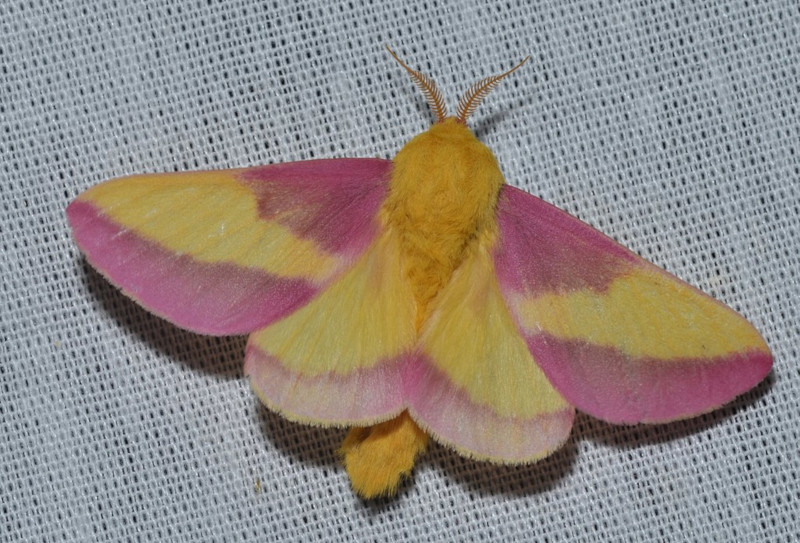
Rosy Maple Moth Facts
- This magnificent variety of Lepidoptera goes by the common name of the Rosy Maple Moth. Its scientific name, meanwhile, remains quite complicated to pronounce. That’s because professional researchers know it by the name of the Dryocampa rubicunda.
- By either of these distinctive terms, however, it represents a truly beautiful work of Nature and evolution. The Danish zoologist Johan Christian Fabricius made the first official recognition of it as a separate and distinct species. This he did in the year 1793.
- In some portions of its habitat range, though, its caterpillar stage is better known than the adult one. That, however, holds true for unfortunate reasons. This stage, commonly known as the greenstriped mapleworm, ranks as a major pest to some individuals.
- Quite fortunately, it also appears to still be maintaining a sizeable and sufficient population base. This trend further seems to hold true throughout the entirety of its natural range. The IUCN, therefore, presently has no listing for it on its Red List.
- The breathtaking Rosy Maple Moth nevertheless must be considered to facing at least some risk. In this, it mirrors most species today. Habitat loss naturally forms a threat. The greatest threat it faces, however, must be considered to be that of climate change.
Related Articles
Rosy Maple Moth Physical Description
The fabulous Rosy Maple Moth perfectly demonstrates the fact that size has no bearing on beauty in Nature. That’s because the delicate marvel actually ranks as the smallest of what’s known as the silk moths. Compared to moths overall, though, it’s an average-sized species.
The small wonder also displays a moderate degree of the physiological characteristic of sexual dimorphism. In its specific case, however, this trait manifests itself in terms of physical size, rather than appearance. More specifically, females grow slightly larger.
The larger females, as a result, attain a wingspan measuring as much as 2 in (5 cm). The smaller males, meanwhile, typically only attain a wingspan averaging roughly 1.25 – 1.75 in (3.2 – 4.4 cm). That degree of size difference isn’t unusual among moths, though.
It’s in its pure appearance, however, that the awesome Rosy Maple Moth distinguishes itself from the crowd. That’s due to its remarkable pattern of colors. The body and hindwings usually manifest as bright yellow. The legs and antennae mainly appear as reddish-pink.
The forewings of the lovely Lepidoptera further enhance its amazing appearance, though. These usually display as bright pink, with a yellow band running across the middle portion. Various white and cream-colored patterns also occur sometimes, however.
- Kingdom: Animalia
- Phylum: Arthropoda
- Class: Insecta
- Order: Lepidoptera
- Family: Saturniidae
- Genus: Dryocampa
- Species: D. rubicunda
Rosy Maple Moth Distribution, Habitat, and Ecology
The marvelous Rosy Maple Moth evolved as native to a comparatively extensive portion of the globe. In point of fact, it developed naturally across a respectable portion of the Northern Hemisphere. More precisely, it appears endemically to parts of North America.
There, it makes its home in portions of the countries of the United States and Canada. Even within that zone of habitation, though, its population appears in only certain portions of the countries. This range further appears to be stable and consistent.
In the United States, it lives mainly in the eastern sections. That extends from Florida west to Michigan, Indiana, Texas, Kansas, and Nebraska. In Canada, meanwhile, it appears in the southern regions. This includes Ontario, Quebec, New Brunswick, and Nova Scotia.
The intrepid small arthropod even extends its range to the equally stunning Prince Edward Island. Wherever it makes its home, though, the marvel of Nature displays strong preferences for its choice of habitat. This preference mainly includes deciduous forests.
The incredible Rosy Maple Moth draws part of its common name from its feeding habits. That’s due to the fact that it principally feeds on Maple trees. The intriguing species further appears to be particularly fond of the Silver Maple, Red Maple, and the Sugar Maple.
Like most of its relatives, it evolved as nocturnal in nature, except during mating season. In the wild, individuals sometimes live as long as 9 months. For the moment, researchers know very little about the rest of the lifecycle of this truly fascinating invertebrate.
Species Sharing Its Range
Check out our other articles on 3 Astonishing African Lizards, Tufted coquette, Waw an Namus, Shameplant, Finless Porpoise, Indian Bullfrog, Executioner Wasp, Rainbow Snake
